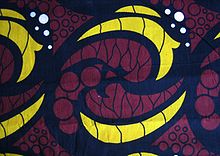Akitengeorchitenge (pl. vitenge Swahili; zitengeinTonga) is an East African, West African and Central African piece of fabric similar to a sarong, often worn by women and wrapped around the chest or waist, over the head as a headscarf, or as a baby sling. Kitenges are made of colorful fabric that contains a variety of patterns and designs. In coastal areas of Kenya and in Tanzania, kitenges often have Swahili sayings written on them. There seems to be a confusion with the Kangas, which indeed carry texts in contrast with kitenges, which apparently typically do not carry texts.[citation needed]


Kitenges are similar to kangas and kikoi, but are of a thicker cloth and have an edging on only a long side. Kenya, Uganda, Tanzania, Sudan, Nigeria, Cameroon, Ghana, Senegal, Liberia, Rwanda, Burundi and Democratic Republic of the Congo are some of the African countries where the kitenge is worn. In Malawi the garment is known as a chitenje and in Namibia and some parts of Zambia it is a chitenge. They are sometimes worn by men around the waist in hot weather. In Malawi, kitenges did not used to be worn by men until recently, when the president encouraged civil servants to buy Malawian products by wearing a kitenge on Fridays.
A kitenge serves as an inexpensive, informal piece of clothing that is often decorated with a wide variety of colors, patterns and even political slogans.
The printing on the cloth is done by an industrialised version of the traditional batik technique originated in Indonesia.[1][2] These are known as wax prints and the design is equally bright and detailed on the obverse side of the fabric. Today, wax prints are commercially made and are almost completely roller printed with less color bleeding through to the obverse side. Many of the designs have a meaning. A large variety of religious and political designs are found as well as traditional tribal patterns. The cloth is used as material for dresses, blouses and pants as well.
Kitenges can be used on occasions and in many ways either symbolically or for practical reasons. Kitenges are used in different settings to convey messages. The following list demonstrates uses of the cloths.
Kitenges have also become very popular as fashion statements in urban pop culture with youth in Africa. Kitenges are incorporated in clothing items such as hoodies, trousers, and accessories such as bags.